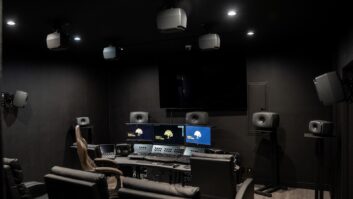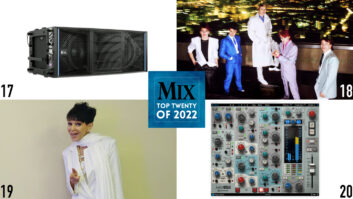Every year brings with it a selection of new and improved studio monitors to help make the most of your mixes. Here’s the low-down on some of the latest:

Auratone Active 5C
It has been 50 years since Auratone founder Jack Wilson released the 5C Super Sound Cube and, in celebration of its golden anniversary, Auratone and its U.S. distributor, TransAudio Group, released the Active 5C.
The mono amplifier is designed and built in Europe in collaboration with Bettermaker. A careful R&D process has been implemented to maintain the original characteristics of the 5C, using the same amplifier design as the A2-30 amplifier.
Like the other 5C variants, the Auratone Active 5C is made in the USA. It delivers 50W into its internal 8-ohm load via a balanced combo XLR/ TRS input. Like the passive version, it reproduces between 80 and 15,000 Hz via a 4.5-inch driver with a signal-to-noise ratio in excess of 100 dB. In addition to an input, the rear of the box provides an on/off switch and power LED. The active 5C has Integrated overcurrent, overheating, and short protection in the rare event of electrical trouble.

IK Multimedia iLoud MTM Immersive Bundle 11
IK Multimedia‘s iLoud MTM studio monitors are now available in the latest Dolby Audio Room Design Tool (DARDT) for Atmos systems, so users can precisely install a multimonitor setup that adheres to Dolby’s standards anywhere. iLoud MTM’s built-in ARC self-calibration means it adjusts in seconds to any placement, including ceiling-mounting, correcting output to ensure precise, balanced sound from every position.
iLoud MTM is intended for multichannel installations being linear phase and having a point-source acoustic performance to be accurate at any distance. This reportedly minimizes the inaccuracies conventional speakers introduce in the imaging, which is critical for multichannel and immersive setups.
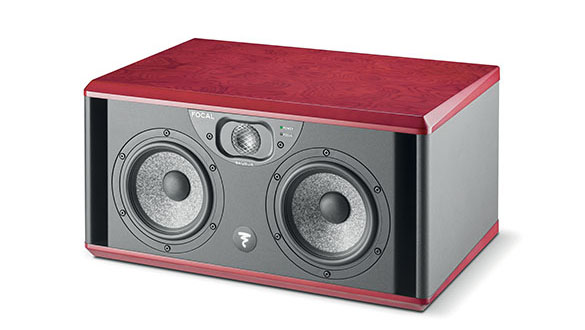
Focal ST6 Line
With its ‘W’ cones and Beryllium tweeters, the ST6 speaker line inherits Focal’s best technologies. The ST6 monitors— including the Twin6, Solo6 and Sub12 — offer multiple features, including Focus mode, variable high-pass crossover, parametric crossover, dis-engageable automatic standby and more.
The Twin6 is a 2.5-way monitor offering transparency, definition level, dynamics and soundstage precision. Its Focus Mode uses a two-way configuration intended to preserve the sweet spot when mixing, saving space on the console and simplifying cabling and monitor changes. The Twin6 boasts an inverted dome Beryllium tweeter with an ‘M’-shaped protective grille and a woofer with a ‘W’-shaped cone, as well as a frequency range of up to 10 kHz, specially designed for the Focus Mode. All this on top of Focal’s patented Tuned Mass Damper (TMD) technology, which reportedly reduces distortion in the 1 kHz–3 kHz frequency range by 50 percent.
The Solo6 is a 2-way monitor that also boasts an inverted dome Beryllium tweeter with an ‘M’-shaped protective grille, and a woofer with a ‘W’-shaped cone, as well as a frequency range of up to 10 kHz, specially designed for the Focus Mode. The Solo6 includes inserts for attaching it to the wall and ceiling. The Sub12 features a 13-inch speaker driver with ‘W’-shaped cone and very high excursion, as well as a BASH amplifier with 600W RMS and 1000W peak-to-peak power. In addition, there are optimized braces and a front vent inspired by Focal’s Trio11 monitors, as well as internal and external vents to reduce noise and distortion.
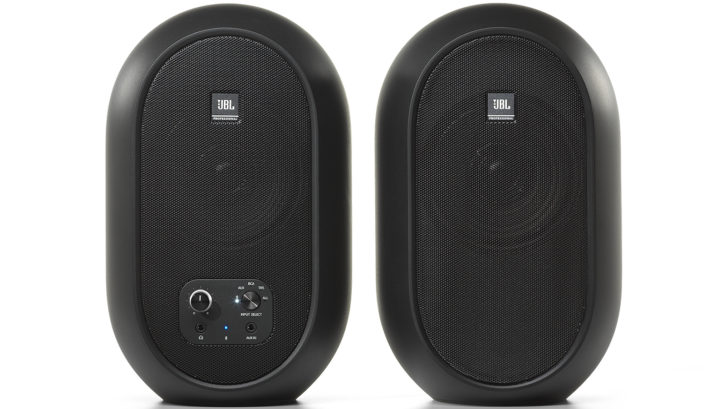
JBL 104-BT Compact Reference Monitors
JBL 104-BT compact reference monitors with Bluetooth, the latest models in the 1 Series line, are designed for recording musicians, producers, podcasters and vloggers, as well as professional audio engineers seeking an accurate, portable reference with Bluetooth streaming.
JBL 104-BT Reference Monitors combine a coaxial 4.5-inch (118 mm) low-frequency driver and .75-inch (19 mm) soft-dome tweeter, integrated 60-watt amplification and an acoustic design to reproduce sound. Bluetooth streaming lets users check mixes over Bluetooth to ensure they sound great in every listening scenario.
Both the black 104-BT and white 104-BTW versions have compact form factors, conserving valuable workspace.
Mix’s 2022 New Studio Headphones Roundup, Part 1
Mix’s 2022 New Studio Headphones Roundup, Part 2

Kali Audio Project Lone Pine – 2nd Wave
Kali’s LP-6 and LP-8 studio monitors have received improvements in the noise floor, output level, frequency response and distortion. With the LP-6 and LP-8, users can mix with more confidence, and they can also be assured that a mix will translate as best as possible to whatever systems the audience is using.
The 2nd Wave goes even further, utilizing a more robust DSP for an even flatter frequency response on the top end. The LPs have been praised for their accuracy, and the company states that the 2nd Wave versions realize slight but noticeable improvements in that regard, particularly on the top end.

KRK V8 Series 4 Powered Reference Monitors
The KRK V8 is a two-way, full-range studio reference monitor with professional performance and accuracy for recording, mixing and mastering. It features a 1-inch, KRK-designed Kevlar tweeter and an 8-inch lightweight KRK-designed woven Kevlar woofer. Using Kevlar for both the woofer and tweeter gives users smooth midrange definition without colorization and clean high-end with tight, controlled low-end, as well as a wide sweet spot and beautiful imaging, according to the company.
The 230W KRK designed, bi-amped Class-D amplifier delivers solid transient speed and up to 118 dB of SPL. KRK’s optimized front-ported bass reflex enclosure design avoids boundary coupling to allow flexibility in room positioning. Forty-nine different DSP-driven EQ presets deliver control for room/desk correction as well as personal taste. The solid aluminum front-baffle and EVA foam pad are like having a built-in stabilizer that improves transient response and imaging.
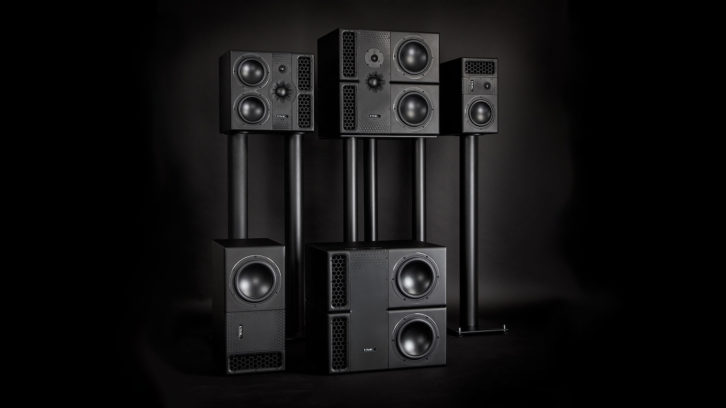
PMC PMC6, PMC6-2 and PMC802
Five years of development at PMC Speakers have culminated in the PMC6, PMC6-2 and PMC8-2, along with their associated subwoofers the PMC8 SUB and PMC8-2 SUB. The low-frequency extension of the new designs belies the cabinet dimension due to advancements in both woofer and ATL bass loading technology. These are scalable systems that can grow to suit the end user’s requirements. The active subs can be combined with the monitors to create one of PMC’s unique twin-cabinet XBD systems that deliver extended bass and dynamics. Alternatively, they can be used as standalone LF monitors for sub channels. Future-proofing has also been engineered into every model with advancements such as an expansion card slot for planned future signal interfacing options.
When it comes to configuration, PMC has paid close attention to making this as straightforward as possible via simple menu-driven controls on the rear panel, or through the company’s SOUNDALIGN network interface. Accessed through wired connections to any standard network via any web-browser on a PC, Mac or tablet, SOUNDALIGN’s digital connectivity allows users to individually control each monitor or set them up in defined groups ideal for large-scale immersive systems.

Genelec Offers Immersive Monitoring Systems Configuration
Genelec has made configuring and managing its Smart Active Monitoring systems even more user-friendly with the introduction of its GLM 4.2 loudspeaker manager software, and the new 9301B multi-channel AES/EBU interface. These two additions to the range allow the cost-effective and seamless creation of scalable immersive monitoring systems up to 16 channels, using one or more bass-managed subwoofers, or 32 channels if using a second 9301B.
The GLM 4.2 update is powered by the fast and precise AutoCal 2 automatic room calibration algorithm and introduces a host of new features, including the GRADE Room Acoustic Report, remote control of key parameters, and improved symmetric calibration of groups of monitors and subwoofers.
By using the information gathered during the AutoCal calibration process, the GRADE report makes GLM the first calibration software in the world to give the user a complete analysis of their room and monitoring system performance, in line with the best practices—including ITU-R BS.1116 recommendations. The report, which as an introductory offer is available free of charge throughout 2022, provides specific observations and advice on any acoustical issues, helping users and studio designers alike to fine-tune the room’s acoustic treatment, adjust monitor and listener positions, and optimize bass management.


